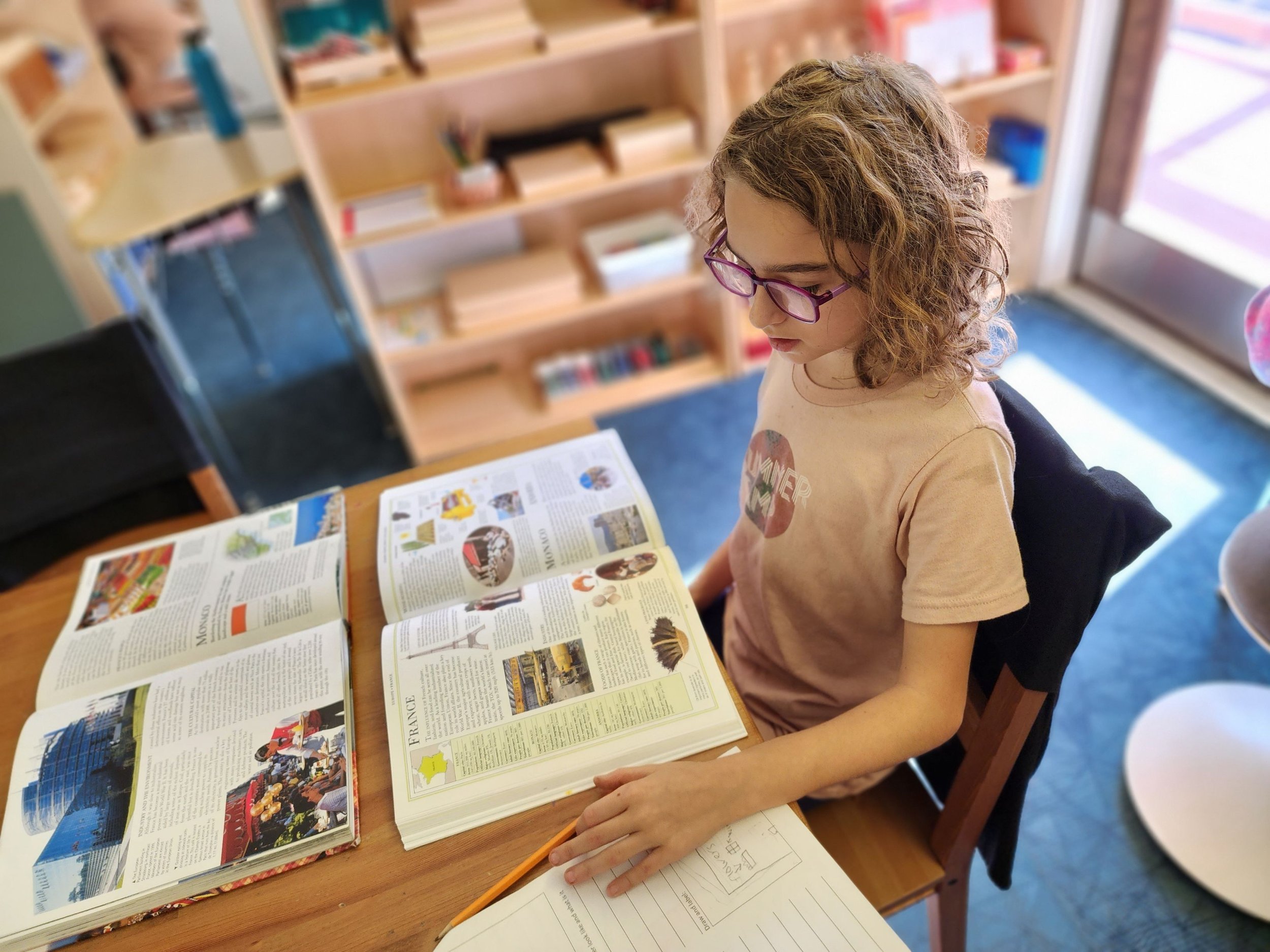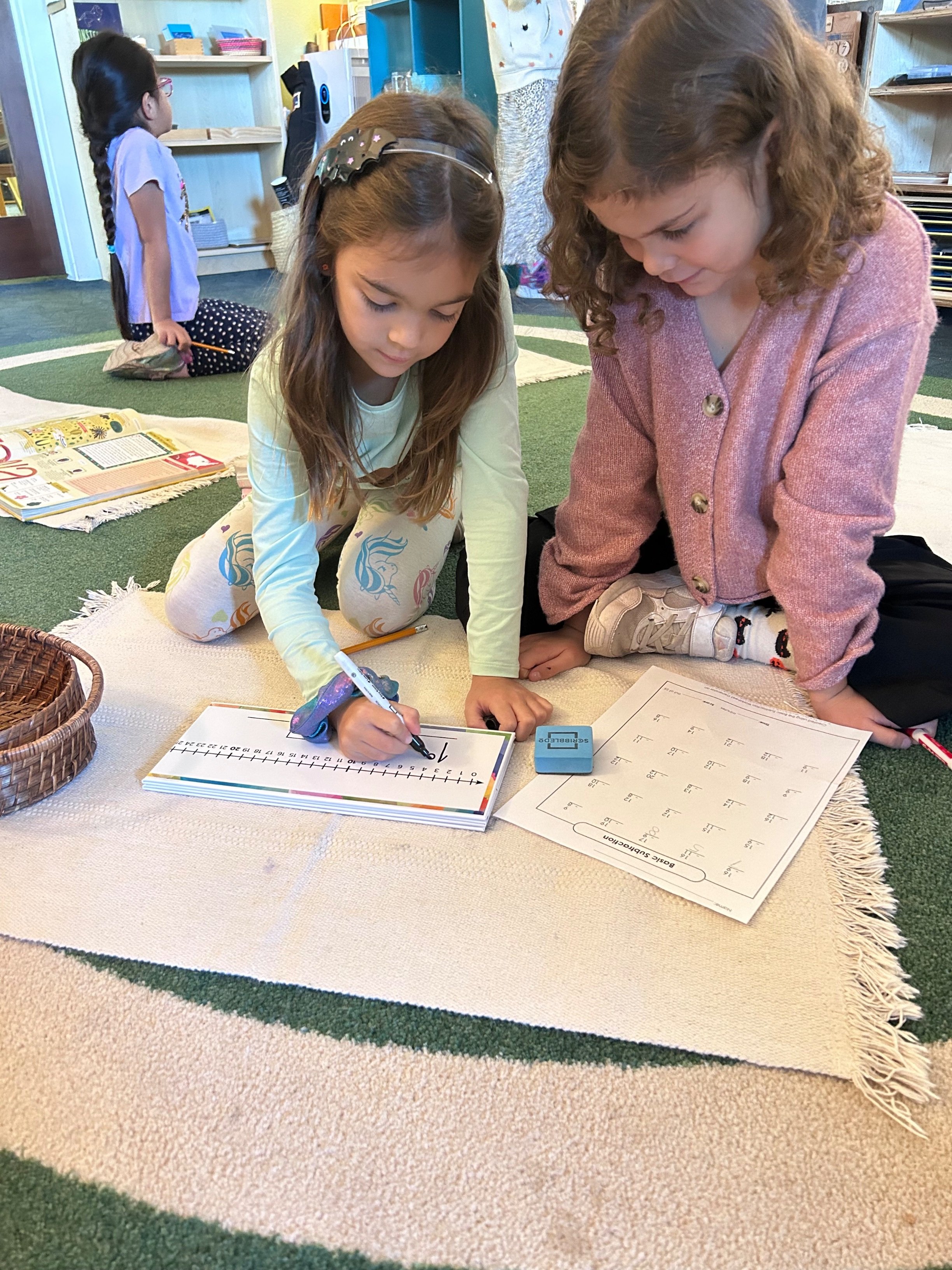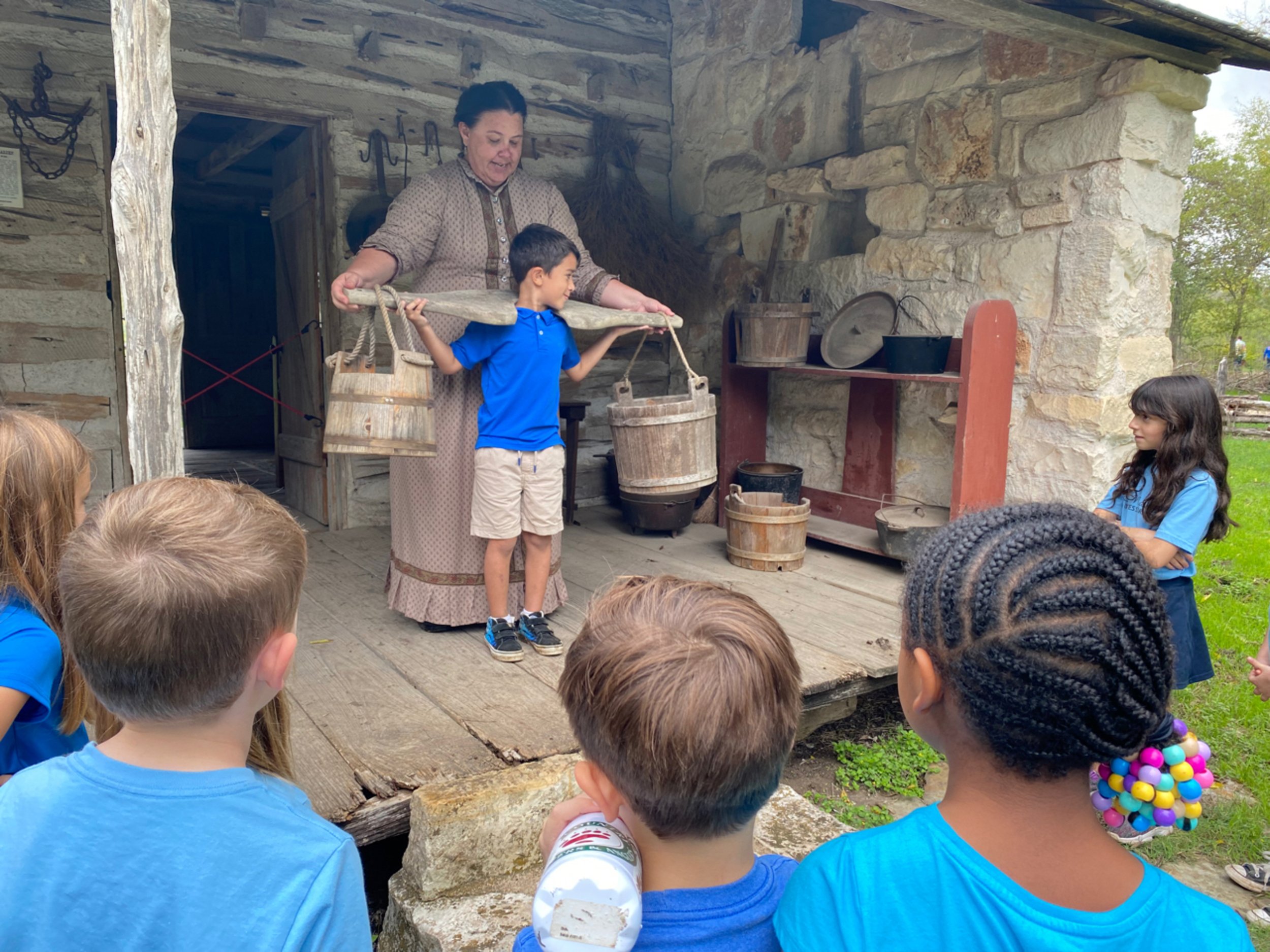LOWER & UPPER ELEMENTARY
In our Elementary classrooms, children ages 6-12 have the opportunity to follow their sense of wonder, develop essential academic skills, practice peaceful community building, and grow in their understanding of the world around them. At these levels, Montessori serves elementary-aged children through a program that promotes learning by offering exploration of big questions about the universe, time, civilizations, communication, and more.
Within this science-based curriculum, subjects like math, geometry, geography, and history naturally coalesce and deepen, creating a truly personalized education limited only by the breadth of a child’s imagination. Students work independently and collaboratively here. They are offered group lessons and individual experiences. Each is celebrated as a valuable and responsible member of our community. Peace education and mindfulness are integral parts of our day. In addition, we meet or exceed the Common Core and Texas State Standards. We do this by observing and assessing children, offering guidance as they move along their individualized learning paths.We value movement and spending time outdoors. Elementary children spend between 1 to 2 hours a day outside, including a healthy daily dose of free play. We also tend gardens, go on nature walks, learn to track animals, and watch clouds.
Formal Physical Education is offered 2 times a week. We offer music, visual and dramatic arts, creative writing, yoga, and computer skills within our curriculum. We love elementary-aged children at Mariposa Montessori and it shows. Our classroom holds high standards but feels like home. Children blossom in our program, becoming leaders, artists, poets, explorers, and promoters of peace in the world.
Benchmarks for our Lower Elementary (6-9 yrs) Program
Benchmarks are a series of skills a student will acquire over the course of their time in a program. A key component of the Montessori approach is the 3-year age groups. Our curriculum is laid out in a three-year schedule as opposed to traditional programs that use an annual curriculum. The three year groups are based on phases of child development which allows us to deemphasize grade levels. We respect each student’s own unique path towards mastery. It is normal for children to learn in spurts and have periods of time when the acquisition of certain skills takes precedence over others. Many of the skills listed are introduced at this level and expanded upon throughout our Elementary program. It is important to stay in communication with your child’s Guide to get a clear picture of their progress. Our format allows students the gift of time while still ensuring they meet state curriculum requirements.
Practical Life/Development
Classroom responsibilities (rotating jobs)
Responsible for composting and recycling
Practices in-classroom greetings
Practices problem solving, active listening, and meaningful apologies
Practices table manners
Practices respecting personal space and boundaries
Practices organizing personal materials
Learns strategies for identifying and navigating feelings
Language
Grammar
Identifies grammar symbols and their stories
Identifies the function of words (parts of speech) in the context of a sentence
Word study: Alphabetizing, rhyming, compound words, syllabication, plurals: regular and irregular, synonyms, antonyms, homonyms, contractions
Basic sentence analysis (subject, predicate, direct object)
Uses complete sentences that include subject and predicate
Understands subject-verb agreement
Uses simple tenses
Understands the rules for capitalization and punctuation
Reading
Informational
Can identify and use text features (title, subtitle, bold, italic, highlights, captions, diagrams, photographs, illustrations, etc.)
Comprehension: WWWWWH questions using text evidence
Can identify Main Idea and Supporting Details
Can compare and contrast information
Can distinguish Fact from Opinion
Can explain the steps of a process/sequence
Can identify an author’s purpose
Can interpret vocabulary and read multisyllabic words
Narrative
Demonstrates comprehension: setting, plot, characters, themes/lessons
Can identify point of view
Introduction to literacy devices (simile, hyperbole, etc.)
Can compare/contrast characters, setting, plot, theme
Can make connections using text evidence
Poetry
Identifying rhymes, patterns, theme/message of common forms
Writing
Uses manuscript lowercase and uppercase
Uses cursive lowercase and uppercase
Spelling: blends, diphthongs, digraphs, short and long vowel patterns, common prefixes (re-, pre-, etc.), common suffixes (-tion, -ly, etc.), common rules: when to change y to I, f to v, doubling final consonants, etc.
Introduction to the writing process (brainstorm to draft, edit/revise to final copy, publish/present)
Introduction to basic informational paragraphs (topics sentence, supporting details, conclusion statement)
Introduction to crafting a narrative story (first, second, and third person perspective; including story elements like setting, character introduction, initial problem, events leading to climax, events leading to resolution)
Knows how to answer questions completely by restating questions in answers and using specific subjects initially before using pronouns
Introduction to common poetry forms (haiku, acronym, couplet, etc.)
Understanding paraphrase
Math
Memorization of addition, subtraction, multiplication, and division fact families 0-10
Develops an understanding of the relationship between addition/subtraction and multiplication/division
Demonstrates mastery of abstract dynamic addition/subtraction with regrouping, making exchanges and borrowing across zeros
Multiplication and division moves from concrete to abstract work with single digit multipliers and divisors
Can place value to millions family
Fractions – identifying numerator and denominator, comparing fractions, fraction equivalency for ½, 1/3, 1/4, adding and subtracting fractions with like denominators, finding lowest terms and equivalency using fraction pieces
Understands the laws of divisibility for 2, 5, 10, 25
Can read a number line
Telling time, familiarity with time phrases, calculating time passed, etc.
U.S. Money – knowledge of coins and bills their names and values, coin combinations, adding and subtracting with dollars and cents, making exchanges for coins
Measurement – using a ruler, practice with both Imperial system measurements and Metric systems measurements
Reading graphs and analyzing information (bar, pie, line, picto)
Familiarity with common word problems – question words and what operations they indicate
Geometry
Types of lines and relationships of lines
Types of angles and their measurements
Plane figures, types of triangles, types of quadrilaterals
Solid figures
Equivalence and congruence with metal insets
Introduction to symmetry
Cultural
History
Timeline of People
Fundamental needs of humans
Ancient civilizations and their contributions
Basic structure of government and citizenship
Life Sciences (Biology, botany, ecology)
Introduction to:
Timeline of life
Kingdoms and introduction to classification
Living vs. Nonliving features
Parts of plant and functions
Food chains and webs in an ecosystem
Life cycle and anatomy of animals from different classifications
Animal defenses (camouflage, mimicry, etc.)
Physical Sciences (Physics and Chemistry)
Introduction to:
Scientific method and inquiry
Identify and classify forms of matter: solid, liquid, gas
Combining mixtures
Magnetism and gravity acting on objects
Push/pull/force acting on objects
Earth and Space (Geology and Geography, Astronomy and Cosmology)
Introduction to:
Work of water, wind, and air
Layers of earth
Sun, moon, and earth systems, solar system
Continents and oceans
Land and water forms
Plate tectonics, volcanoes, and earthqakes
Weather patterns, Fahrenheit vs. Celsius
Reading a map (title, legend, compass rose, scale, grid sections)
benchmarks for our upper elementary (9-12 yrs) Program
Language
Spelling
Multisyllabic words with closed syllables, open syllables, VC’s syllables, vowel teams, including digraphs and diphthongs, r-controlled syllables and final stable syllables
Words with consonant changes, including /t/ to /sh/ such as in “select” and “selection” and /k/ to /sh/ such as “music” and “musician”
Spelling words using knowledge of affixes, including how suffixes can change base words such as dropping e, changing y to I, and doubling final consonants
Grammar
Firm understanding of the parts of speech and sentence analysis
Uses print or digital resources to determine meaning, syllabication, pronunciation, and word origin
Uses context within and beyond a sentence to determine the relevant meaning of unfamiliar words or multiple-meaning words
Writing
Understands the writing process, including proof reading and editing
Understands basic formats for formal writing
Practiced in various types of texts including essays, summaries, poetry, letters, and stories
Familiar with writing process including author’s voice, word choice, sentence fluency, conventions, etc.
Familiar with the practice of peer editing
Reading
Familiar with a variety of literary genres
Demonstrates reading comprehension skills including:
Ability to identify Main Idea and details
Understands Plot Development
Ability to create character analysis
Ability to make inferences
Math
Can use multiplication/long division with 2-3 digit divisors/multipliers
Pre-algebra concepts: Variables, parentheses, brackets, equations/inequality
Understanding of the Sieve of Eratosthenes (Prime numbers) and familiar with factor trees
Understands fractions:
Can identify numerators and denominators
Equivalent fractions
Familiar with proper, improper, and mixed fractions
Familiar with +/- like and unlike denominators
Understands fractions as division
Familiar with simplifying fractions using the greatest common factor
Understands decimals:
Decimals as fractions
Understands comparing and ordering
Understands computation with operations
Can read a Number Line
Understands U.S. Currency
Understands Graphing (positive numbers, ordered pairs, finding the rule)
Familiar with Metric conversions
Familiar with interpreting data: Probability, Median, Mode, Range, and Mean
Familiar with reading graphs (bar, line, pie, scatter, picto, etc.)
Can solve multi-step word problems
Understands Mathematics in practical life (baking, measuring, accounting, time, etc.)
Geometry
Understands basic geometry concepts, including:
Points, Lines and Planes
Types and relationships of lines
Polygons: congruence, equivalence, and similarity
Lines of Symmetry and Rotational Symmetry
Perimeters of Polygons and Complex Shapes
Finding the Area of Quadrilaterals, Complex Shapes, Triangles, and Circles
Finding Volume for Geometric solids
Sciences
Life Sciences (Biology, Botany, Zoology, Ecology, Human Anatomy)
A knowledge of how living organisms are organized in science
The use of a microscope
Study of Prokaryotic and Eukaryotic Cells
Familiar with the different Kingdoms
Study of Botany
Study of the Biomes of the world
Human Anatomy
Physical Sciences (Physics, Chemistry)
Physics
Understands the Scientific Method
Study of Buoyancy, Gravity, Inertia, Newton’s Laws of Motion)
Study of Simple Machines and Magnetism (Inclined Plane, Log Roller, Lever, Wheel and Axel, Crankshaft, Pulley)
Study of Electricity (Static, Simple, Circuits, Conductors, Simple Switch, Series Circuits, Parallel Circuits, Morse Code)
Study of Sound (Waves, Moves Outward, Feeling/Seeing Vibrations. Direction of Sound, traveling through water, Echoes, Pitch and Frequency of Sound)
Chemistry
Understands the States of Matter
Understands Physical and Chemical changes
Understands Mixtures and Solutions
Study of Viscosity
Study of the Periodic Table of Elements, Atoms, Compounds, Energy, and Chemical Reactions
Understands Applied Chemistry
Physical Sciences (Astronomy, Geology)
Astronomy
Study of the Stars, Planets and Solar System
Understanding of Meteorology
Geology
Study of the Layers of the Earth, Meridians, Latitudes and Longitudes, Hemispheres
Study of a Rock Cycle, Mountain formation, Volcanoes
Study of Minerals, Geodes, Fossils
Geography
Study of Pangea
Study of Texas geography
Study of the Oceans of the World
Study of the Maps of the World
Study of Types of Maps and Map Skills
Understanding of Functional Geography
Study of U.S. Geography by Region
Study of the Continents and their Nations
History
Texas History
Study of Texas history from the First Peoples to the Twentieth Century
U.S. History
Study of U.S. history from the First People in the Americas through the early Twentieth Century
World History
Study of World History including Prehistory, Early Civilizations, and the development of Civilizations on all continents
Outdoor Education
Understands basic gardening: weeding, planting, watering
Familiar with wood working
Knowledge of Plant Identification and Classification
Familiar with animal care
Music
Understanding of reading music
Practice with Tone Bars and Scales
Knowledge of Music terms
Art
Practice with various forms of media including: origami, watercolor, pencil, collage and paper mâché
Study of Art Concepts
Study of Functional art
Practical Life/Development
Study of Identity and Diversity
Study of Executive Functioning Skills and application
Study of Equity and Justice
Study of Communications Skills
Experiences with collaboration



